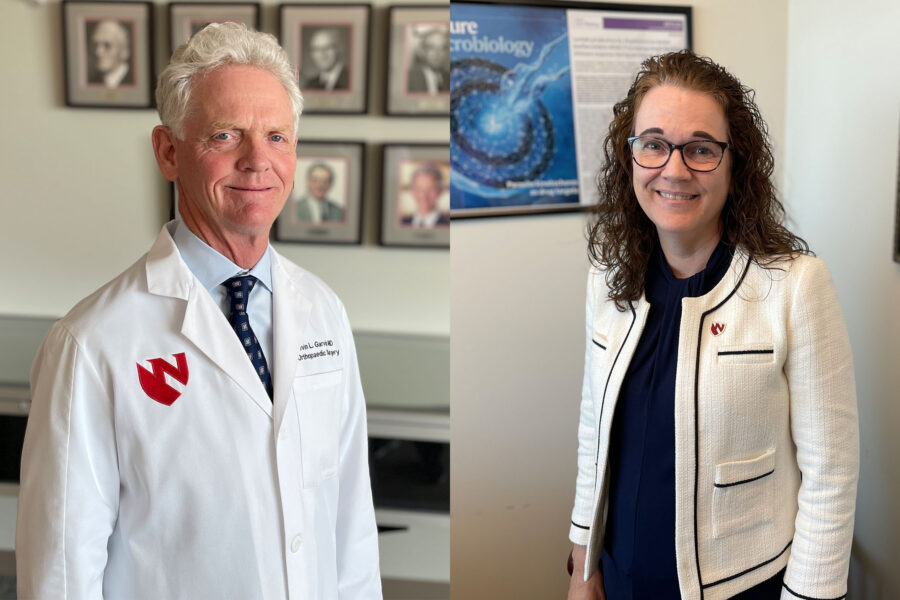A paper published earlier this year in the Journal of Clinical Investigation by a UNMC team of researchers and collaborators suggests a path for dealing with bacterial biofilm that can form on artificial joint implants and resist the attempts of the body’s immune system to clear it.
Tammy Kielian, PhD, professor in the UNMC Department of Pathology, Microbiology and Immunology, and Kevin Garvin, MD, chair of the UNMC Department of Orthopaedic Surgery, led a team that saw success in treating a biofilm-infected surface, reducing bacterial burden dramatically without having to remove the artificial joint.
The process, developed in animal models, is a longstanding project, and the new paper is just the latest collaborative effort to explore how to deal with these biofilms, which are frustratingly able to avoid attack by the body’s immune system, Dr. Kielian said.
As a result, biofilm infections in humans currently almost always require the removal of the infected implant, which can lead to other complications.
Patients suffering from a biofilm-associated prosthetic joint infection are faced with a tremendous challenge, Dr. Garvin said.
“Typically, patients require surgery to remove the prosthesis and excise infected and necrotic tissue, followed by a six-week course of parenteral antibiotics. If the recovery is favorable, a prosthetic joint can be reimplanted.
“While the outcome of reimplantation is 80 to 90% successful, the morbidity and mortality associated with two operations and IV antibiotics are alarmingly high,” he said. “The potential of this research under the direction and leadership of Dr. Kielian will lessen the need for surgical treatment and has the potential to be one of the greatest contributions in decades for patients who suffer from a prosthetic joint infection.”
The team worked to better understand why the immune system was not working well in these cases and to reprogram that response to be better able to recognize these biofilms, which are really challenging to treat.
“The bacteria in these biofilms have many ways to trick the immune system,” Dr. Kielian said. “The biofilm is giving signals that make the immune system dysfunctional. It’s basically cloaking itself, if you will, giving the wrong signal – kind of, ‘Hey, don’t worry about killing us.’”
In the new study, the team developed a nanoparticle-delivered drug to an immune cell that normally is immune suppressive, making them better able to recognize the biofilm as being foreign and to attack it, Dr. Kielian said. “We now have good information on changes that happen in both our mouse model and human samples, and we’re using that information to try to develop new therapeutic approaches down the road.”
In the recently published paper in The Journal of Clinical Investigation, the team and lead authors Prabhakar Arumugam, PhD, and Christopher Horn, PhD, targeted one cell type that is known to be important for preventing bacterial clearance, but more work is planned.
“We’re working toward a combinational approach, because the immune responses in these infections, both in animal models as well as human patients, are very complex. But I do feel that we are making some good advances.”
Dr. Kielian said she was excited that the signals the team saw in human cells donated by patients with these infections were similar to the reactions in animal models.
“That means our mouse model is really a good system for us to continue to test new therapies,” she said. “We feel confident that this is an excellent system.”
Dr. Garvin also expressed optimism.
“In time, we hope to see clinical evaluation of this translational research and compare it to our standard treatments,” he said.
Dr. Kielian called the collaboration at UNMC a game changer, particularly with Curtis Hartman, MD, of the department of orthopaedic surgery, providing access to several samples from his patients with prosthetic joint infection.
“Dr. Hartman and I have been honored to participate in this exciting research,” Dr. Garvin said. “It is an ideal situation in which Dr. Kielian and her team have developed a scientifically favorable model that has included our patients’ tissue. We now have five surgeons who manage patients with prosthetic joint infection and are excited for the future. The patients, too, are hopeful and will be enthusiastic contributors as they hope future patients will benefit from this research.”
“Being able to collaborate with these clinicians just really elevates this work overall,” Dr. Kielian said. “Not all investigators have access to patient samples. We don’t know their identity, of course, but we appreciate the patients who agreed to have their tissues used for our research, which would otherwise be discarded. These scientific advances wouldn’t be possible without these generous people.
“And hopefully, because of them, we will have an impact on clinical practice in the future.”
